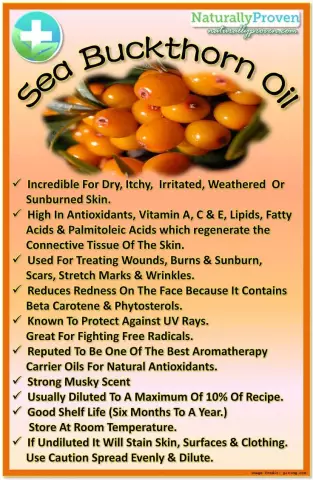- Author Rachel Wainwright [email protected].
- Public 2023-12-15 07:39.
- Last modified 2025-11-02 20:14.
Sea salt
Description of sea salt
Sea salt is the name given to salt, usually obtained naturally from the sea. Compared to ordinary salt, sea salt is distinguished by a significantly higher amount of minerals.

The tradition of extracting salt from the sea is quite ancient and goes back over 4000 years. It is believed that the inhabitants of the countries of East Asia (India, Japan, China) and the Mediterranean (Italy, France, Spain) were the first to evaporate salt. "Digestion" of sea water is typical for countries with colder climates, for example, for England.
The main feature of sea salt is its unique balanced composition, which does not require additional enrichment. For centuries, the beneficial properties of sea salt have been used to treat a wide variety of diseases.
Sea salt is used both in cooking and in industrial plants in the production of chlorine and caustic soda.
Useful properties of sea salt
The sea salt treatment has the same ancient history as the sea water treatment. Even in ancient times, the properties of sea salt were used, contributing to:
- Improving blood circulation and elasticity of skin and tissues;
- Acceleration of interstitial metabolic processes;
- Reducing spasms, pain and inflammation;
- Skin cell regeneration;
- Reducing stress levels.
External use of sea salt improves blood circulation and increases the activity of all metabolic processes.
Sea salt is the basis of many procedures in balneotherapy (treatment with mineral waters). By acting on the autonomic nervous system, it heals stress, relieves spasms and stimulates the pineal gland.
There are more than a dozen diseases that, with regular procedures, can be cured with sea salt. Among them:
- Arthrosis and arthritis;
- Swelling;
- Sinusitis and otitis media;
- Radiculitis;
- Hypertension;
- Mastopathy;
- Circulatory disorders;
- Fungi;
- Periodontal disease;
- Rheumatism;
- Constipation and diarrhea;
- Conjunctivitis.
Composition of sea salt
Unlike refined table salt, sea salt contains over 80 trace elements essential for health in a bioavailable form, including:
- Sodium and potassium, which are involved in nutritional regulation and cell cleaning;
- Calcium, which plays an important role in the prevention of infections and wound healing, as well as in the formation of cell membranes;
- Magnesium, which is needed to relax muscles and prevent aging;
- Manganese, which is involved in strengthening the immune system and building bone tissue;
- Copper, which prevents the development of anemia;
- Bromine, which has a beneficial effect on the nervous system;
- Selenium, which prevents the development of cancer;
- Iodine, which helps to regulate hormonal metabolism;
- Chlorine, necessary for the formation of blood plasma and gastric juice;
- Iron and zinc, which are involved in the formation of erythrocytes and the formation of immunity;
- Silicon, which helps to strengthen tissues and elasticity of blood vessels.
The composition of sea salt largely depends on where it is mined. So, the Dead Sea, located in Israel, has such a high concentration of salt that water does not allow immersion in it and pushes the human body to the surface without difficulty. It is believed that salt from the Dead Sea has pronounced medicinal properties, most widely used in cosmetology.
The benefits of sea salt
The use of sea salt internally contributes to the treatment of many diseases. So, the benefits of sea salt have been proven to lower blood pressure, which is achieved by balancing sodium. In addition, sea salt is effective in preventing many heart diseases and helping to lower cholesterol levels.
Due to its rich mineral composition, the benefits of sea salt are also noted:
- To "alkalize" the body, which helps to prevent the development of many serious diseases of the body;
- In the treatment of various skin diseases;
- To strengthen the immune system;
- To reduce excess weight, stimulate digestion and prevent the accumulation of toxins;
- When treating asthma (by slowing down the production of phlegm);
- To ensure the correct electrolyte balance in the body, which has a beneficial effect on the nervous system and cellular functions;
- To normalize sleep;
- To maintain proper blood sugar levels;
- In the treatment of various types of depression, because sea salt promotes the production of two main hormones in the body (serotonin and melatonin) that help to cope with stress.
Application of sea salt
Sea salt is used both in cooking and in medical procedures.
It is considered useful when preparing food to replace table salt with sea salt or use a mixture of them in a 1: 1 ratio, which will help to get significantly more useful minerals.

There are also various folk recipes for using sea salt internally in the treatment of various diseases. So, if you drink a glass of warm water with half a teaspoon of sea salt before bedtime, it helps to improve sleep and increase its duration. In addition, it helps with a runny nose, which occurs both with the flu and those that are allergic in nature.
Outwardly, sea salt can be used in the form of baths. To do this, dissolve 1-2 kilograms of natural sea salt in the bath and lie in it for 15-20 minutes. After that, you should wipe yourself with a towel and go to bed. The procedures are recommended every other day. The total number of baths per course is 10-15. Such procedures are especially effective for diseases of the cardiovascular system. They also help eliminate toxins and relieve fatigue. Sea salt baths can be combined with a variety of aromatic oils.
Also, sea salt can be applied externally in the form of rubbing, which is a good prevention of colds, significantly improves blood circulation and strengthens the immune system. In addition, rubbing with sea salt evens out skin color, removes cellulite, cleanses the skin and gives it elasticity and firmness.
There are various recipes for using sea salt for grinding. According to one of them, it is necessary to mix a glass of vodka, half a liter of water, 20 drops of iodine and 2 tablespoons of sea salt, then rub the whole body from the limbs towards the heart area with a hard mitten moistened with a solution.
For diseases of the lungs, nasopharynx and bronchi, as well as for sinusitis, sore throat and colds, it is effective to inhale with sea salt. For them, boil a liter of water and add 2 tablespoons of sea salt to it. Inhalation is carried out for 15 minutes twice a day, usually in the morning and evening. In case of diseases of the bronchi, it is recommended to inhale through the mouth, and exhale through the nose, and in case of a cold, vice versa.
Also, sea salt is traditionally used in cosmetology. It is found in many masks, creams, lotions and tonics. Cosmetics with sea salt help to tighten pores, rejuvenate the skin and improve complexion.
YouTube video related to the article:
Found a mistake in the text? Select it and press Ctrl + Enter.






